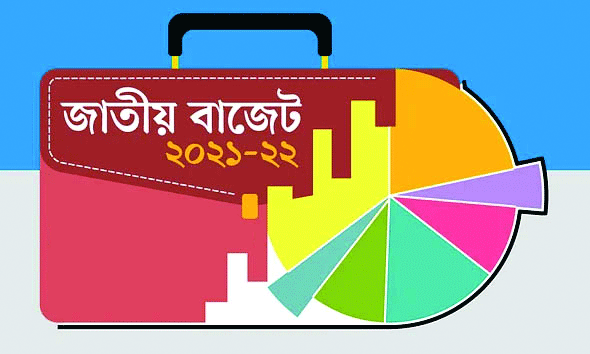Tk 6.03 tr budget passed estimating 16.5pc of GDP
Mahfuz Emran: The budget for the FY 2021-22 has been passed in the parliament. The size of the budget is estimated at Tk 6.03 trillion (Tk 603,061 crore), which is 16.5% of the total GDP. This is the third consecutive budget of the Awami League government.
Of this, a total allocation of Tk 38,356 crore has been made in other sectors including management and Tk 2,25,324 crore has been allocated in the annual development program.
On Wednesday (June 30), Finance Minister AHM Mustafa Kamal proposed to pass the bill (Specification Bill, 2021) to provide for the payment and allocation authority from the consolidated fund for the fiscal year ending June 30, 2022, and it was passed by voice vote.
Speaker presided over the session. Shirin Sharmin Chowdhury. Although Prime Minister and Leader of the House Sheikh Hasina was present in Parliament, Leader of the Opposition Raushan Ershad was not. The new financial year will start tomorrow, July 1.
Earlier yesterday (Tuesday), the National Assembly passed a budget for the fiscal year 2021-22 with the decision to continue the ‘special’ opportunity given to black money in the industrial sector.
Earlier on June 3, the finance minister presented the budget in the parliament. After that the proposed budget was discussed at length in the Parliament session.
The health sector has been given the most importance in this year’s budget. Besides, implementation of incentive packages announced by the Prime Minister, agricultural sector, food production and management have been given more importance in tackling COVID-19. Throughout the financial year, the government will have various food-friendly programs, the scope of social security programs will be increased. Sector-wise allocation
Health, agriculture and job creation have been given priority in the budget allocation for the annual development program. In the annual development program of FY 2021-22, 29.4 percent in human resources (education, health and other related) sectors, 21.7 percent in overall agricultural sector (agriculture, rural development and rural institutions, water resources and other related), 12 in power and energy sector. 1 per cent, 26.4 per cent in communication infrastructure (roads, railways, bridges and other communication related sectors) and 10.4 per cent in other sectors.
Budget deficit
This year’s budget deficit will be Tk 2,14,071 crore, which is 7.2 percent of GDP. This rate was 7.1 percent in the last budget. One lakh one thousand 227 crore taka will be collected from foreign sources and one lakh 13 thousand 452 crore taka from domestic sources to finance the deficit. Of the internal sources, Tk 6,452 crore will be collected from the banking system and Tk 36,001 crore will come from savings and other non-banking sectors.
Expenditure structure
According to the hierarchy of work performed by different ministries and departments, the work is divided into three main parts. These are – social infrastructure, physical infrastructure and general services. In the proposed budget, an allocation of Tk 1,60,510 crore has been proposed for the social infrastructure sector, which is 26.25 per cent of the total allocation; Of this, one lakh 55 thousand 746 crore has been proposed for allocation in human resource sector (education, health and other related sectors). In the physical infrastructure sector, one lakh 89 thousand 81 crore taka or 29.6 percent has been proposed; Of which 74,102 crore in the overall agriculture and rural development sector; 69,464 crore in the communications infrastructure sector and Tk. 26,484 crore in the power and energy sector.
One lakh 45 thousand 150 crore has been proposed in the general services sector, which is 24.04 percent of the total allocation. Expenditure for Public-Private Partnership (PPP), financial assistance in various industries, subsidies, investment in state-owned, commercial and financial institutions has been proposed to be Tk 34,748 crore, which is 5.74 per cent of the total allocation. 7,589 crore has been proposed for interest payment, which is 11.37 per cent of the total allocation. Net lending and other expenditure has been proposed at Tk 5,103 crore, which is 0.75 per cent of the total allocation.
Medium term policy
Achieving Bangladesh’s consistently high GDP growth over the past decade has been temporarily hampered by the impact of COVID-19. Although a record 7.15 percent growth was achieved in the last 2018-19 fiscal year, it decreased to 5.2 percent in the 2019-20 fiscal year due to coronavirus. However, the GDP growth target for the current fiscal was set at 8.20 percent, assuming that the economy would recover from the impact of Kovid-19 in the 2020-21 fiscal.
But due to the prolonged effects of the epidemic and the announcement of the second wave of coronavirus and lockdown in various countries of the world, including Bangladesh, there has been a slowdown in economic activities. Besides, the desired pace of exports and imports has not returned. However, the GDP growth estimate for the current financial year has been revised to 6.1 per cent, taking into account the achievement of the desired growth in expatriate income and the implementation of the large-scale stimulus package announced by the government for economic recovery.
In addition, the growth rate has been set at 7.2 percent in FY 2021-22 in line with the long-term plan, taking into account the passage of Kovid-19. Inflation is targeted at 5.3 percent. The main source of growth in the medium term is strong domestic demand. On the other hand, there are targets to accelerate GDP growth and create employment by boosting the growth of the industrial sector in terms of supply. This goal is expected to be achieved through expeditious implementation of the establishment of economic zones.
Rare Israeli airstrike in Beirut kills Hezbollah commander and more than a dozen others
International Desk: Israel launched a rare airstrike that killed a senior Hezbollah milita…








